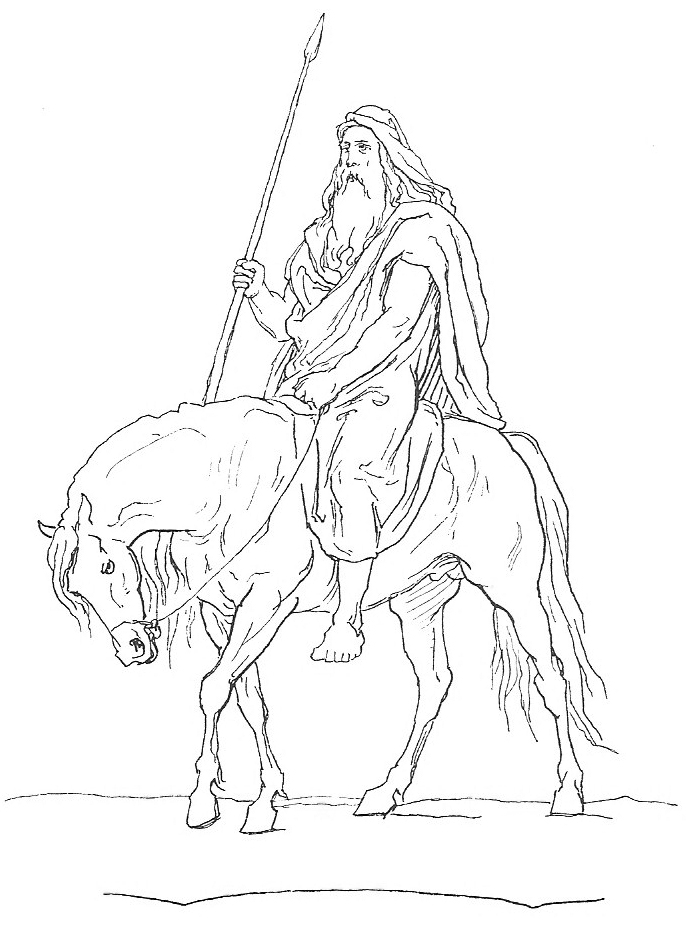Gungnir is a magical spear belonging to Odin. Like many weapons, Gungnir symbolizes power. Gungnir also symbolizes authority, protection and strength.
Of all the weapons in Norse mythology, the weapon of the god Odin (Óðinn) is considered one of the most powerful. Where Gungnir ranks compared to other weapons is hotly debated, especially when compared to Thor’s hammer, Mjölnir.
Regardless of the criteria, Gungnir consistently ranks in the top 5 most powerful weapons in Norse mythology.
Perhaps more interesting than its powers are the origins of Gungnir. Forged by skilled dwarves and gifted to Odin by Loki, Gungnir is a fantastic piece of weaponry with an exciting backstory.
The making of Gungnir
Gungnir was forged from Uru metals, found exclusively in Asgard’s realm. Gungnir was created by dwarves known as the Sons of Ivaldi.
The skilled dwarf blacksmith Dvalin oversaw the creation of Gungnir, which was to be a gift for the Norse god Odin.
In Old Norse, Gungnir means to tremble or to sway. While it is sometimes called “the spear of heaven,” Gungnir is also called “the swaying one.” This is because the very sight of this glorious and powerful spear causes enemies to sway, trembling with fear.
Gungnir was also an important part of Norse mythology. Odin threw the spear over the heads of the Vanir gods, which started the Æsir-Vanir war. Odin carried the spear with him everywhere.
In the end of days–called Ragnarök–Odin led the warriors of Valhalla into battle, confronting the great wolf Fenrir with Gungnir held firmly in his grasp.

Frölich, Lorentz
Where did Odin get Gungnir?
Loki commissioned the making of Gungnir by the Sons of Ivaldi.
Loki presented Gungnir as a gift to the god Odin as reparation for cutting the goddess Sif’s golden hair without her permission.
The Sons of Ivaldi made three items at this time:
- Sif’s headdress made from golden wheat
- Gungnir
- And Freyr’s mighty ship, Skidbladnir
The ever-cunning Loki challenged dwarves Sindri and Brokkr to create gifts of equal value to those from the sons of Ivaldi. In response to Loki’s goading, Sindri and Brokkr created their own gifts for the Norse gods:
- Freyr’s pig, Gullinbursti
- The soul ring, Draupnir
- Thor’s hammer, Mjölnir
Loki commissioned each of these 6 items to the gods to atone for cutting Sif’s hair.
When Loki returned to Asgard, he gave Draupnir and Gungnir to Odin. To Odin’s wife, Freyja, Loki gifted Gullinbursti and Skidbladnir. Loki gave Thor his hammer, and to Sif, he gave a headdress to replace her long golden hair.
What does Gungnir symbolize?
Like many weapons, Gungnir symbolizes power. Gungnir also symbolizes authority, protection, and strength.
Imbued with magic and always true, this mighty weapon is steady and relentless, a true powerhouse in the world of mythical Norse weaponry.
Properties of Gungnir
Most notable are the magical properties of the runes carved on the head of the spear. These runes ensured no matter the distance or what stood in its path, Gungnir would hit the target without fail.
Along with being imbued with magical accuracy, Gungnir itself was a masterfully crafted weapon. Perfectly weighted and balanced, Gungnir flew straight and true no matter the strength of the wielder.
Gungnir’s spear tip was also the sharpest blade in existence.
Forged from Uru metals and covered with runes, there was no weapon in Norse mythology that measured up to Gungnir.

Gungnir Vs. Mjolnir
When you remove the Norse gods from the equation and look at the merits of Gungnir versus Mjolnir as weapons, Gungnir is the clear winner.
Mjölnir’s strength and power depend on Thor. Gungnir is deadly sharp, perfectly balanced, and magically accurate no matter who handles the spear.
Mjölnir is one of the most well-known weapons in Norse mythology. But its strength and accuracy come directly from Thor himself. Additionally, Thor’s belt and glove increased Mjölnir’s powers.
Since Gungnir’s greatness doesn’t rely on any outside influence, Gungnir is the clear winner between the two weapons.
How did Gungnir influence the warriors of the Viking age?
Archaeological records from the Viking age make it clear that Gungnir significantly influenced the warriors of the time. They even fashioned their weapons to imitate the spear of Odin. Viking age warriors carve runes on their spearheads to improve their accuracy.
The way the Norse god Odin used his spear also inspired ancient warriors on the battlefield. Like Odin, warriors would send their spears flying, sinking into the ground beyond the enemy. This was a clear invitation to battle.
Gungnir in Wagner’s Ring of the Nibelung
Gungnir has also inspired countless comics, movies, and even a 19th-century opera by German composer Robert Wagner.
While attestations from both the Prose Edda and the Poetic Edda make it clear that the spear of Odin was made from Uru metal, Wagner imagined much humbler origins for Gungnir.
In Wagner’s Ring of the Nibelung, Gungnir was fashioned from the wood of the World Tree Yggdrasil.

